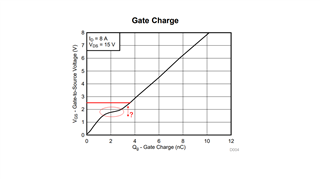- Ask a related questionWhat is a related question?A related question is a question created from another question. When the related question is created, it will be automatically linked to the original question.
This thread has been locked.
If you have a related question, please click the "Ask a related question" button in the top right corner. The newly created question will be automatically linked to this question.
Thank you very much for your help.
I am considering the CSD17318Q2 and have a question on the basic use of FETs.
I am planning to use VGS at 2.5V.
When I checked the Gate Charge graph, I found that the Miller Plateau has a VGS of about 1.8V, so I thought 2.5V would be sufficient to drive it.
Does the VGS of Miller Plateau fluctuate up and down depending on temperature, drain current, etc.?
Thank you very much for your cooperation.

Hello Taro-san,
Thanks for your interest in TI FETs. You should be OK driving the CSD17318Q2 with VGS = 2.5V. You should always provide a gate drive voltage >= the minimum value of VGS where on resistance is specified in the datasheet. The CSD17318Q2 on resistance is specified down to a minimum VGS = 2.5V. TI does not spec or test the Miller plateau in production. Data is only collected during product development. There will be some part-to-part and lot-to-lot variation but that should have minimal effect on your application as long as you provide adequate gate drive voltage as mentioned above.
Best Regards,
John Wallace
TI FET Applications
John san Hello.
I understand that it can be used with VGS = 2.5V.
For your reference, is the minimum value of VGS the maximum value of VGS(th) (=1.2V)?
Or does it mean the 2.5V shown in the characteristic graph on the datasheet?
Thank you very much for your help.
Hello Taro-san,
The threshold voltage is specified and tested at ID = 250uA, where the FET just begins to turn on and conduct current. VGS = 2.5V is the minimum voltage where on resistance is specified, tested and guaranteed. If the FET is driven with VGS < 2.5V, TI cannot guarantee on resistance at that voltage.
Best Regards,
John